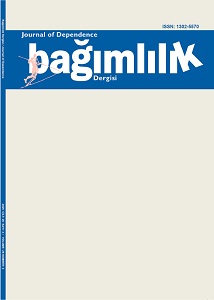RELATİONSHİP WİTH CLİNİCAL FEATURES OF THE MALE DEPENDENT PATİENTS AND THEİR PARENT’S ATTACHMENT STYLE AND LOCUS OF CONTROL
Keywords:
Addiction, attachment styles, parental, locus of controlAbstract
Objective: The aim of this study was to investigate the relationship between clinical characteristics of male substance abuse patients and their parents and their attachment styles and loci of control.
Methods: Forty-six outpatients and their parents were admitted to this study. All participants were diagnosed as having substance use disorder (SUD) based on DSM-IV TR. Data were gathered by means of the researcher-prepared Information Form, the Adult Attachment Style Questionnaire, and the Rotter Internal-External Locus of Control Scale. The study was approved by the Ethical Committee of Uskudar University.
Results: All of the patients were male; mean age was 27.54 (±7.07). A statistically significant relationship between the attachment styles of parents and patients was found (χ2 = 12.081, p = 0.017). No statistically significant relation was found between the method of admission to the hospital and participants’ loci of control.
Conclusion: In conclusion, a patient’s attachment style is related to that of his parents. It is suggested that, despite a patient’s high internal locus of control, those who reported that they sought treatment at the request of their family were either negatively impacted by their parents’ actions, or perhaps by previous counsel regarding addiction, resulting in a lowering of the patient’s desire to seek help.
References
Fichter MM, Narrow WE, Roper MT, et al. Prevalence of mental illness in Germany and the United states. Comparison of the upper Bavarian study and the epidemiologic catchment area programm. J Nerv Ment Dis 1996; 184(19):598–606.
Kessler RC, McGonagle KA, et al. Lifetime and 12-Month Prevalence of DSM-III-R Psychiatric Disorders in the United States. Arch Gen Psychiatry 1994; 51: 8–19.
Regier DA, Farmer ME, Rae DS, et al. Comorbidity of mental disorders with alcohol and other drug abuse. Results from the Epidemiologic Catchment Area (ECA) Study. JAMA 1990; 264: 2511–2518.
Bowlby J. The nature of the child’s tie to his mother. Int J Psychoanal 1958; 39: 350-373.
Schindler A, Thomasius R, Sack P-M, et al. Attachment and substance use disorders: A review of the literature and a study in drug dependent adolescents. Attach Hum Dev 2005; 7(3):207-228.
Gerra G, Zaimovic A, Garofano L, et al. Perceived parenting behavior in the childhood of cocaine users: Relationship with genotype and personality traits. American Journal of Medical Genetics Part B: Neuropsychiatric Genetics 2007; 144(1): 52-57
Rotter JB. Generalized expectancies for internal versus external control of reinforcements. Psychological Monographs 1966; 80: 1-28.
Schultz D, Schultz SE. Modern Psikoloji Tarihi, Çev. Aslay, Y. Kaknüs Yayınları, İstanbul, 2002
Pektaş Ö, Mırsal H, Kalyoncu A, ve ark. Remisyondaki alkol bağımlılarında kontrol odağı. Bağımlılık Dergisi 2003; 4: 72-75.
Hexel M. Alexithymia and attachment style in relation to locus of control. Personality and Individual Differences 2003; 35:1261-1270.
Hazan C, Shaver PR. Romantic love conceptualized as an attachment process. Journal of Personality and Social Psychology 1987; 52: 511-524.
Mikulincer M, Florian V, Tolmacz R. Attachment styles and fear of personal death: A case study of affect regulation. Journal of Personality and Social Psychology 1990; 58(2):273-280.
Kesebir S, Kökçü F, Dereboy F. Erişkin bağlanma biçimi ölçeği: Geçerlilik ve güvenilirlik çalışması. New/Yeni Symposium Journal 2012; 50(2): 99-103.
Dağ İ. Rotter’in iç-dış kontrol odağı ölçeğinin üniversite öğrencileri için güvenirliği ve geçerliği. Psikoloji Dergisi 1991; 26:10-17.
Icick R, Lauer S, Romo L, Dupuy G, Lépine JP, Vorspan F. Dysfunctional parental styles perceived during childhood in outpatients with substance use disorders. Psychiatry Res. 2013; 210(2): 522-528.
Bulut M, Savaş HA, Cansel N, Selek S, Kap Ö, Yumru M, Virit O. Gaziantep Üniversitesi alkol ve madde kullanım bozuklukları birimine başvuran hastaların sosyodemografik özellikleri. Bağımlılık Dergisi 2006;7(2): 65-70.
Türkiye Uyuşturucu ve Uyuşturucu Bağımlılığı İzleme Merkezi (TUBİM), EM-CDDA 2013 Ulusal Raporu (2012 Verileri) Reitox Ulusal Temas Noktası. 2013;18-21.
Calicchia JP. Narcotic addiction and perceived locus of control. Journal of Clinical Psychology 1974; 30(4): 499-504.
Karen D, Abigail JE,Tim T, Jan ŠC. Who do you think is in control in addiction? A pilot study on drug-related locus of control beliefs. Addict Disord Their Treat 2012; 11(4): 173–223.
Hochreich DJ. Sex Role stereotypes for internal-external control and interpersonal trust. Journal of Consulting and Clinical Psychology 1975;43:273.
Thorberg FA, Lwers M. Attachment, fear of intimacy and differentiation of self among clients in substance disorder treatment facilities. Addict Behav 2006; 31(4): 732-737.
Wedekind D, Bandelow B, Heitmann S, et al. Attachment style, anxiety coping, and personality-styles in withdrawn alcohol addicted inpatients. Subst Abuse Treat Prev Policy 2013; 8: 1-7.
George C, Hunter MS. Who’s really in charge of my life, anyway? Locus of control and cognitive substance abuse treatment in a Federal prison. Journal of Rational-Emotive and Cognitive-Behavior Therapy 1994; 12: 219-227.
Downloads
Published
How to Cite
Issue
Section
License
Copyright (c) 2025 Journal of Dependence

This work is licensed under a Creative Commons Attribution-NonCommercial-NoDerivatives 4.0 International License.
...
